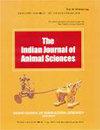非季节性降雨/洪水引起的迁徙羊中蓝舌病和小脚病暴发:特别提及BTV血清型12
IF 0.3
4区 农林科学
Q4 AGRICULTURE, DAIRY & ANIMAL SCIENCE
引用次数: 0
摘要
在2019年10月至11月的暴雨和洪水之后,在受洪水影响地区的迁徙绵羊中发现了蓝舌病暴发。在卡纳塔克邦的15只迁徙羊群中调查了该疾病,共涉及3575只羊,其中1480多只患病,428只死亡。对208只患病动物和79只死亡动物进行了基于NS1基因组的群体特异性蓝舌病病毒(BTV)逆转录- pcr (RT-PCR)检测,随后进行了基于2段基因组的血清型特异性蓝舌病病毒(BTV)检测。RT-PCR和系统发育分析证实,本次暴发涉及的病毒为BTV血清型12。这些数据进一步深入了解了BT流行病学,并建议在流行地区将当地流行的BTV血清型/s纳入疫苗中,以有效控制BT。由于持续降雨,这些迁徙的羊被迫在积水的农田/土地上站立数天至数周,它们同时感染了由坏死梭杆菌和金黄色葡萄球菌引起的急性足疾。在本次暴发中,足槽和高级抗生素对治疗足疾非常有效。目前的研究证明了不可预见的自然灾害如何破坏动物健康,并产生深远的社会经济后果,最终影响食物链,并且已经尝试了一些科学措施来减轻这种动物健康危机。本文章由计算机程序翻译,如有差异,请以英文原文为准。
Bluetongue and footrot outbreaks in migratory Sheep due to unseasonal rains/ floods: Special reference to BTV Serotype 12
Following heavy rains and floods during October-November of 2019, outbreaks of Bluetongue (BT) disease was witnessed in migratory sheep in flood affected areas. The disease was investigated in fifteen migratory flocks in Karnataka state, involving a total of 3575 sheep with over 1480 ailing and 428 deaths. Samples collected from 208 ailing and 79 dead animals were initially subjected for NS1 genome based group specific Bluetongue virus (BTV) detection by Reverse Transcription-PCR (RT-PCR) and later for segment 2 genome based serotype specific RTPCR. The RT-PCR and phylogenetic analysis confirmed the virus involved in the current outbreak as BTV serotype 12. This data gives further insights into BT epidemiology and recommends inclusion of locally circulating BTV serotype/s in vaccines in endemic regions for effective control of BT. Since these migratory sheep were forced to stand in water stagnated agricultural fields/lands for days to weeks due to continuous rains, they were concurrently affected with acute footrot caused by Fusobacterium necrophorum and Staphylococcus aureus. Foot-tanks and higher antibiotics were very effective in treatment of footrot in the current outbreak. Present study is an evidence of how unforeseen natural calamities can disrupt animal health with profound socio-economic consequences eventually affecting the food-chain and here a few scientific measures have been attempted to mitigate such animal health crisis.
求助全文
通过发布文献求助,成功后即可免费获取论文全文。
去求助
来源期刊

Indian Journal of Animal Sciences
农林科学-奶制品与动物科学
CiteScore
0.60
自引率
25.00%
发文量
220
审稿时长
8 months
期刊介绍:
Articles published in The Indian Journal of Animal Sciences encompass a broad range of research topics in animal health and production related to cattle, buffalo, sheep, goat, camel, equines, pig, rabbit, yak, mithun, poultry and fisheries. Studies involving wildlife species and laboratory animal species that address fundamental questions about their biology will also be considered for publication. All manuscripts must present some new development and must be original, timely, significant and scientifically excellent. Papers will be rejected if standards of care of, or procedures performed on animals are not up to those expected of humane veterinary scientists. At a minimum, standards must meet the International Guiding Principles for Biomedical Research involving Animals, as issued by the Council for International Organizations of Medical Sciences. (C.I.O.M.S., c/o WHO, CH 1211 Geneva 27, Switzerland). Articles reporting new animal disease must follow GOI directive as given in detail in Guidelines to Authors.
 求助内容:
求助内容: 应助结果提醒方式:
应助结果提醒方式:


